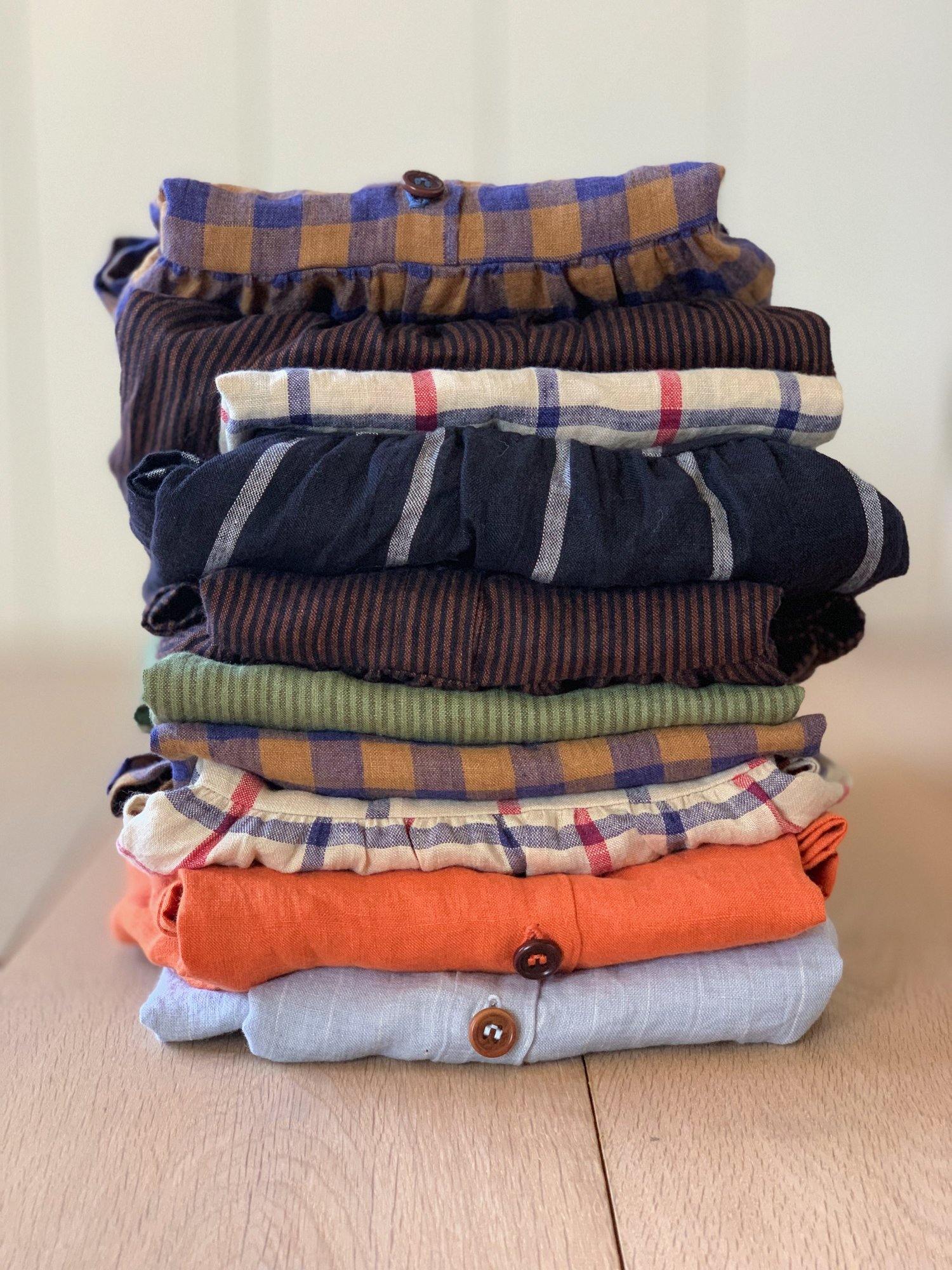Linen is an amazing natural fabric that is low maintenance and lasts a long time. It’s a unique natural material that is sturdy, durable and resistant to bacteria, moths and perspiration. Linen washes better than every other natural material whilst maintaining its quality, and the more it’s washed, the softer and more beautiful it becomes.
We’ve created this in depth guide in order to help you care for and lengthen the life of your linen products. Keep in mind that over washing is not good for clothes, so we advise to only wash your linen items when needed and to spot treat stains rather than wash the whole article. Some linens, especially those untreated or more complex shapes such as suits or jackets, may have more specific instructions for washing. So, of course, always follow the instructions on product tags before washing.
Washing
A good quality linen lasts a long time, but in order to ensure they will last for their maximum lifetime it is best to hand wash or machine wash on a low temperature (cold or lukewarm) with a mild detergent. A mild detergent would typically mean any detergent that is scent-dye free, a detergent designed for baby clothes, or a specific linen detergent.
Avoid detergent with Optical Brightening Agents, as they may cause colour alteration. These will be labelled as:
-
Disodium Diaminostilbene Disulfonate
-
DMS
-
Fluorescent Brighteners
-
Fluorescent Brightening Agents
-
Fluorescent Optical Brighteners
-
Fluorescent White Dyes
-
Fluorescent Whitening Agents (FWAs)
-
Optical Brightening Agents (OBAs)
-
Optical Whiteners
-
Organic Fluorescent Dyes
Avoid detergent with added fabric softener, most fabric softeners available do not work on linen and can leave a residue, and NEVER use bleach on linen! No, not even for white linen. Bleach is linen’s worst enemy, and can cause the fibre to rip or wear out much quicker.
It is also best to wash linen in soft water if you can. I live in an area with very hard water and my linen dresses are still buttery soft after several years of washing, so no need to worry too much about that.

Drying
You can tumble dry your linen products on a low heat/delicate setting assuming their shape is simple (items like pleated trousers may be best air dried). Machine drying on high can cause the linen fibres to break or even shrink.
Be sure to remove from the drier whilst the item is still damp and either hang dry on a padded hanger or lie flat to dry, avoiding ‘bleeding’ surfaces such as painted surfaces or wood.
If you choose to air dry make sure there is an air flow that keeps the dress moving while it dries. This will help avoid that initial stiff feeling when the linen dries. I air dry my linen dresses either outside in a breeze or hanging inside near a fan. Don’t worry, even if your linen item is initially stiff after drying, it will relax and soften with regular wearing and washing.
Ironing
Part of the appeal is the natural crinkle texture that linen holds, so for some there is no need to iron linen. We love this texture, but there are times you may want to iron linen, possibly for presentation. Linen irons best when damp on a medium/high setting. If the dress is dry be sure to use the steam setting on the iron to dampen it before ironing. Iron the reverse side to get out the wrinkles and avoid creating a shine, but do not iron linen to a crease.
Stains
The wonderful thing about linen is that stains lift easily from the fabric, making the stain removal process less stressful than most other fabrics. Always treat a stain before washing and hang dry to make sure the stain has cleared. If you machine dry the stain will set in the fabric and make it more difficult to get out.
Again, do NOT use bleach products. Bleach is our worst enemy.
Do not use hydrogen peroxide based stain removers.
First thing to do is remove the excess stain from the surface using a sharpish object, such as a card or butter knife. You don’t want to dab or rub or you will push the stain more into the fabric.
To spot clean a stain, we usually go straight for the dishwasher soap. We swear by Blue Dawn dish soap to get any stains out of our Pyne & Smith dresses. Wet the spot with cool water, add a drop of Dawn blue, dab lightly then rinse. Once its out wash and air dry. Another way is to get the stain wet, sprinkle on baking soda and a few drops of vinegar and blotch excess liquid with a paper towel, then rinse, wash and air dry.
If you only have other products for spot cleaning (and it’s an emergency!) be sure to test it first. Put a tiny dab of the removal on an inside seam or hem and then dab it with a Q-tip. If it comes off clean, you’re good (similar to sticking a toothpick in brownies to make sure they’re baked). If color transfers onto the Q-tip do not use it on the stain.
